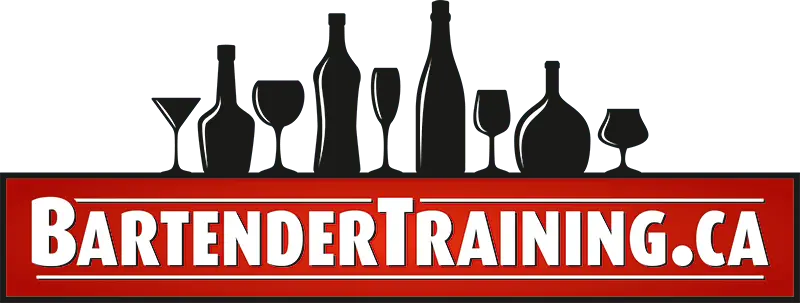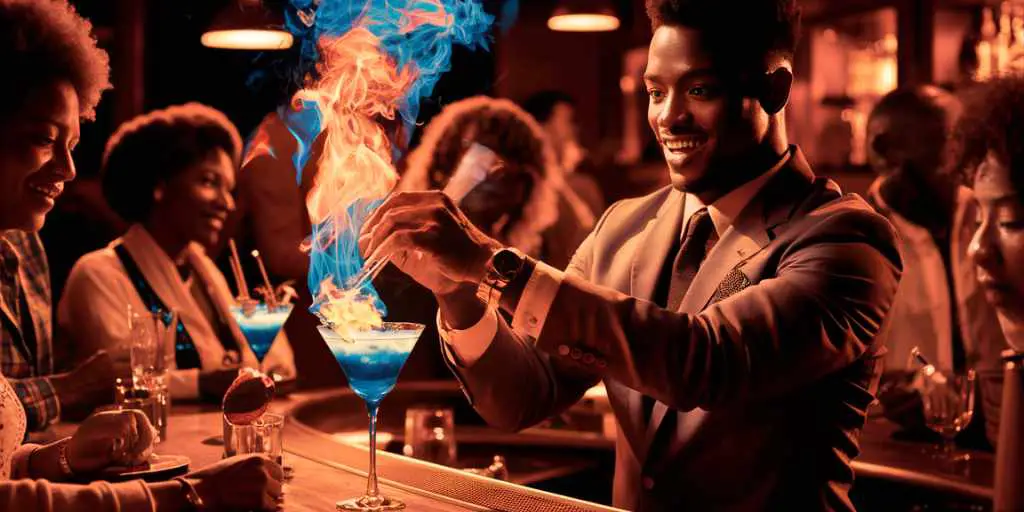Behind every great bar, an even greater bartender mixes the best cocktails and knows how to strike up a good conversation with customers. The art of bartender and customer conversation is a dance of words and drinks, setting the mood for a fun night out.
Key Takeaways:
- Master Small Talk: It’s a great conversation starter and helps you connect with your customers.
- Go Deeper, But Be Respectful: Show genuine interest and ask deeper questions, but avoid crossing personal boundaries.
- Make Recommendations: Suggest drinks based on the customer’s preferences. This shows your expertise and interest in their satisfaction.
- Remember to Engage Everyone: Don’t forget to greet guests and make everyone feel welcome, even when you’re busy.
Section 1: The Art of Conversation at the Bar
Understand the Importance of Communication in Bartending
In bartending, mixing drinks is half the job, while communication is the other half. A bartender must serve drinks, watch the crowd, and ensure the bar runs smoothly. However, they must also master the art of conversation. From fostering a welcoming atmosphere to developing loyal customers, good communication is vital in the bartending industry.
Do Master the Art of Small Talk – With Icebreakers
The beauty of small talk is often underestimated. As a bartender, mastering this art is key to setting the mood and building customer rapport. Icebreakers, those great conversation starters, are often simple and light-hearted. You could comment on the weather, ask about a guest’s favourite sports team, or even talk about current events. The aim is to make the person talking feel comfortable and engaged.
Take Your Conversation to a Deeper Level
While small talk is great for breaking the ice, diving deeper into meaningful conversations can create a lasting bond with your customers. A few tips to take your conversation to a deeper level include showing genuine interest, making eye contact, and asking more profound questions. Remember, it’s a big mistake to dominate the conversation. Be a good listener, give your customer the room to talk, and respond with thoughtful comments.
Section 2: Conversation Starters for Work Appropriate Topics
Navigating work-appropriate topics as a bartender might seem challenging, but it’s all about keeping it casual, light, and engaging. Here are some great conversation starters:
- Music: “I heard this song for the first time last night. Have you heard it before? What kind of music do you enjoy?”
- Upcoming holiday: “Are you doing anything fun for the upcoming holiday?”
- Current Events: “Did you catch the news about [insert non-political current event]? What’s your take on it?”
Section 3: Do Make Recommendations
Your knowledge of drinks is an invaluable resource for customers. Using this to recommend different drinks or suggest personalized cocktails is a fantastic way to start a conversation. When you suggest a drink, you show a genuine interest in the customer’s preferences. This makes them feel seen and appreciated, creating conversation and a stronger relationship.
Section 4: Don’t Forget to Greet Guests When You’re Busy
A bustling bar can be chaotic, but never too chaotic to forget a friendly greeting. Making eye contact, flashing a warm smile, and acknowledging a customer’s presence, even when you’re swamped, shows respect and appreciation. This sets the tone for a pleasant exchange later and leaves a positive impression.
Section 5: Do Develop a Knowledge of International Trends
Bartending is a globally connected profession. Knowing international trends enhances your professional skills and offers interesting topics to discuss with customers. Whether it’s the latest cocktail fad in Paris or a popular drink in Tokyo, your customers will appreciate your international insight. The more you know, the more engaging your conversations can be.
Section 6: Essential Do’s and Don’ts for Bartender-Customer Conversation
So far, we’ve talked about various aspects of bartender-customer conversations. Let’s compile some of the key do’s and don’ts to ensure every chat with your customers is a memorable experience.
- Do find common ground with your customer. People love talking about their interests and experiences.
- Don’t engage in controversial topics like politics. It’s a surefire way to create tension.
- Do give your customer a compliment. A simple “I love your watch” can be a great conversation starter.
- Don’t forget to engage with every guest, even if you’re busy. No one should feel left out.
Section 7: Cultural Sensitivity
You’ll likely encounter customers from diverse cultural backgrounds in an increasingly globalised world. Understanding and respecting cultural differences can greatly enhance the quality of conversation.
Respect and Understanding
Every culture has its unique norms and etiquette. As a bartender, respecting these differences helps create an inclusive and comfortable environment for all guests. Take time to educate yourself about different cultures; if you’re uncertain about something, it’s always better to ask politely rather than make assumptions.
Language Barriers
If a customer doesn’t speak English fluently, be patient and try to communicate as clearly as possible. Simple gestures and visual aids, like pointing to the drinks menu, can be very helpful. A friendly and patient attitude can make a world of difference in making non-native English language speakers feel welcome.
Cultural Nuances in Drinks
Different cultures have unique drinks and drinking customs. Showing knowledge and respect for these traditions can be a great conversation starter and make customers feel valued and understood. For instance, you could recommend a popular drink in a customer’s home country.
Recognize Cultural Holidays and Events
Acknowledging cultural holidays and events is another way of showing respect for your customers’ backgrounds. If you hear that it’s a significant day in a culture and you have patrons from that culture, acknowledging the day can show your awareness and sensitivity.
Cultural sensitivity is more than just good service; it’s about showing genuine respect and appreciation for your customers’ diverse backgrounds. Incorporating it into your conversations can enhance your rapport with patrons and create a more inclusive and welcoming bar environment.
Don’t go overboard with this, though, as it can come across as condescending or patronizing if overdone.
Section 8: The Role of Non-verbal Communication
While words and sounds are a key part of conversation, non-verbal cues are equally important. These can often communicate more about your attitude and intent than any words could.
Eye Contact
Making eye contact is crucial. It signals to the customer that you’re actively engaged in the conversation and are interested in what they’re saying. However, be careful not to stare too intensely, as it can be off-putting.
Body Language
Your body language should be open and inviting. Stand straight, face your customers when they’re speaking to you, and avoid crossing your arms, as it can come off as defensive or uninterested. Remember, your body language can often say more about your feelings than words can.
Facial Expressions
Your facial expressions contribute significantly to the impression you make on customers. Smiling puts your customers at ease and portrays you as friendly and approachable.
Gestures
Use natural gestures that match your conversation and show enthusiasm. For example, a simple thumbs-up can add a sense of camaraderie. However, be cautious not to overdo it, as excessive gesturing can come off as inauthentic or overwhelming.
Touch
While generally, it’s better to avoid physical contact to respect personal boundaries; some situations may allow for it, like a friendly fist bump or a pat on the back. Always gauge the customer’s comfort level and ensure any physical contact is appropriate and consensual.
Remember, mastering non-verbal communication is just as important as honing your verbal skills. Being aware of your body language and consciously adjusting it can greatly improve the quality of your bartender and customer conversations.
Section 9: Tips for Remembering Regular Customers

Part of becoming a successful bartender is building relationships with your regular customers is key to fostering a friendly bar atmosphere and ensuring repeat business. Here are some tips on remembering your regulars to enhance the experience.
Take Note of Their Favorite Drinks
If a customer frequently orders a particular drink, remember it. The next time they walk into your bar, you can ask, “The usual?” This shows your attentiveness and makes the customer feel special and valued.
Use Memory Techniques
Use mnemonic devices or association techniques to remember customers’ and friends’ names. For instance, associate their names with a unique physical characteristic, a favourite drink, or an interesting story they’ve shared. If you’re looking for memory training aids, you can find these online.
Engage in Personal Chats
Showing interest in your customers’ lives and recalling details from past conversations can make them feel valued and welcome. Did they mention an upcoming holiday? Ask them about it the next time they visit.
Make a Mental Note of Their Visiting Patterns
Does a customer come in every Friday night? Or do they prefer quiet Tuesday evenings? Recognizing and remembering their habits can help you anticipate their visits and preferences.
Leverage Technology
Many modern bars use digital systems to keep track of their customer’s preferences. If your bar uses such a system, use it to keep notes on regular customers’ preferences.
Remembering your regulars is about more than just boosting business; it’s a genuine gesture of respect and appreciation. As a bartender, your role is not only to serve drinks but also to create a welcoming and familiar environment for your customers.
The Last Sip: Wrapping it Up
In the world of bartending, the perfect cocktail is a mix of great drinks and engaging conversation. So, go ahead and start pouring the charm along with the rest of the drinks!
Frequently Asked Questions About Conversation Starters
Here are some questions we found that most people usually ask about talking with customers at work.
How do bartenders interact with customers?
Bartenders interact with customers by initiating conversation, showing genuine interest, recommending drinks, and providing great service. They must balance friendliness and professionalism.
Can bartenders talk to their customers?
Absolutely. Bartenders not only can but should talk to their customers. Engaging in conversation helps create a friendly and comfortable atmosphere at the bar.
What do you talk about with customers at a bar?
You can discuss topics like current events, music, sports, or popular culture. The key is to keep the conversation light, enjoyable, and respectful.
How can a bartender engage with all guests when the bar is busy?
It’s all about multitasking. A quick greeting or a nod can let a guest know they’ve been acknowledged, even if you can’t immediately serve them.
How should a bartender greet customers and introduce yourself as the bartender?
A simple “Hello, I’m [Your Name], your bartender for the night. What can I get you?” is a good start. A warm smile and eye contact can make a positive impression.
How do you talk to customers in a bar?
It’s essential to be polite, attentive, and responsive. Show interest in the person, their preferences and thoughts, and engage them with friendly conversation.
What are the five P’s of a professional bartender?
The five P’s are Product, Presentation, Professionalism, Personality, and Passion. These embody the knowledge, skills, and attitude that a professional bartender should have.
How do you make small talk?
Start a conversation with light topics like the weather, a compliment, or a casual question about their day. Small talk aims to make the customer feel comfortable and open the door to a more engaging conversation.
How do you deal with difficult customers in a bar?
A8: Stay calm, patient, and professional. Try to understand their concerns and address them respectfully. If a situation escalates, don’t hesitate to involve security or management.
What not to do as a bartender?
Do not ignore customers, engage in controversial or inappropriate topics, or violate professional boundaries. Also, avoid serving alcohol to intoxicated customers.
How do you start a good conversation with customers?
A good conversation starts with a friendly greeting and open-ended questions. Show genuine interest in their responses and respond thoughtfully.
What are the three things you don’t talk about in a bar?
The three topics generally avoided in a bar are religion, politics, and personal issues. These topics can potentially lead to heated debates and uncomfortable situations between strangers.
How can I be a confident bartender?
Knowledge is the key to confidence. Learn about various drinks, improve your mixology skills, and stay updated with the latest trends. Also, practice communication skills and learn how to handle different situations at the bar. Remember, confidence comes with experience and continuous learning.
Is it okay to discuss personal matters with customers?
While chatting and being friendly is key, it’s crucial to maintain professional boundaries. It’s usually best to keep the conversation light and fun.




